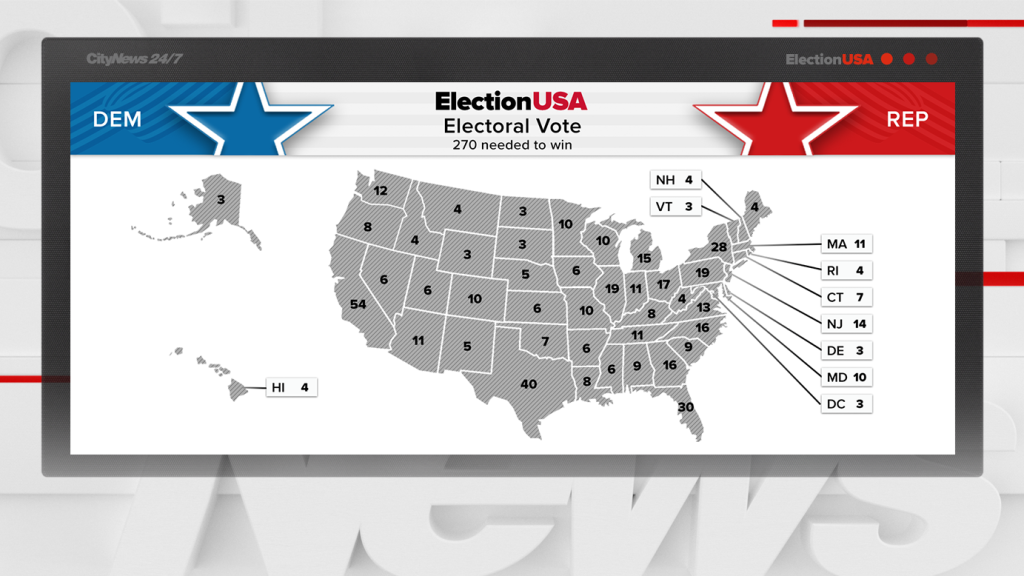U.S. election: How does the Electoral College work?
Posted November 5, 2024 9:00 pm.
Last Updated November 5, 2024 9:42 pm.
As counties and districts across the United States of America begin the process of counting ballots, deciding who becomes the next president and vice president depends more on the U.S. Electoral College versus the national popular vote.

There are 538 Electoral College votes up for grabs during a presidential election campaign and 270 votes are needed to win.
After all the ballots are counted following the U.S. election, each state must confirm the winners in mid-December. That’s when Electoral College voters cast their ballots.
The Electoral College votes are counted during a joint session of Congress in early January. Once the president and vice president are confirmed, they are sworn in on Jan. 20.
CityNews spoke with three U.S. political experts to better understand how the Electoral College works, and all three talked about how the system has become outdated amid ongoing questions about fairness.
History of the U.S. Electoral CollegeWhen the country’s founders came together and drafted the constitution, there was a debate about how future presidents and vice presidents would be elected, and the Electoral College was created, but it didn’t take long for criticisms to arise.
Alex Keyssar, author of Why do we still have the electoral college? and a professor of history and social policy at Harvard University, told CityNews the system was designed at a time when they didn’t “imagine the existence of political parties.”
“The framers of the Constitution left almost all matters dealing with voting rights and election processes to the states. They did that not particularly at a principle, but because every state already had its own particular system and they were worried that if they adopted one system or another some state might get annoyed and not ratify the Constitution,” he said.
“The Electoral College has been significantly unpopular for I’d say approximately 225 years … the ink was barely dried on the Constitution with efforts to significantly reform it or in some cases even abolish it.”
Matthew Lebo, a political science professor at Western University, called the system “archaic and strange.”
“It made perhaps some sense at the time. It was meant to sort of put a body of elites in between the votes of the people and the ultimate selection of the president. It was put in to give smaller states a little bit more power than their populations perhaps warranted,” he said.
Melissa Haussman, a retired political science professor at Carleton University, noted residents used to vote for the president and vice president separately on the ballot.
“That didn’t work so well in a couple of elections … and so they had to change it,” referring to a Constitutional amendment that required the president and vice president to be counted as one vote.
How are Electoral College points allocated?There are 538 Electoral College votes in total consisting of three source: 435 members of, and congressional districts in, the House of Representatives, 100 members of the Senate and three Electoral College votes for the city of Washington, D.C.
“Each state is granted a number of electoral votes equivalent to its representatives in the House of Representatives plus its two senators, which means that it’s roughly proportional to population,” Keyssar said, adding smaller states have a per-capita advantage.
California, Texas and Florida are the three biggest states with Electoral College votes.
“But then there’s a lot of second-tier states which are quite important as well — places like Michigan, Wisconsin, Pennsylvania, Ohio and so those we’re seeing right now are battleground states,” Haussman said.
In 48 of 50 states, whoever has the most votes wins the state’s electoral votes. It’s not winner-take-all in Nebraska and Maine. Lebo explained why this can be problematic.
“Kamala Harris will win California by probably 10 million votes, but she only needs to win by one vote when all the Electoral College votes from California,” he said ahead of election day.
“Joe Biden won by seven million votes in 2020, but if you moved about 40,000 votes within six states he would have lost.”
A map of the United States of America with the number of Electoral College votes each state has. CITYNEWS What happens if there’s a tie in the electoral college?The experts said it’s unlikely there will be a tie and it’s only happened two times in American history: John Quincy Adams in the 1824 presidential race and Richard Mentor Johnson in the 1837 vice presidential race.
When there’s a 269-269 Electoral College tie, it triggers a contingent election. The decision surrounding the president falls to the incoming House of Representatives.
“They don’t vote where one member of the house gets one vote. It’s each state delegation that gets one vote. So there are 50 votes in the House, and so whichever party holds a majority of state delegations would have the advantage to vote for their favourite candidate for president,” Lebo said.
“In the Senate, they do something similar where every senator gets a vote and they choose the vice president and the Senate doesn’t have to choose the vice president from the same party as the house chooses.”
Lebo described the procedure as “arcane” and said it “can’t deal with the kind of partisan deadlock that the country is at right now.”



















































